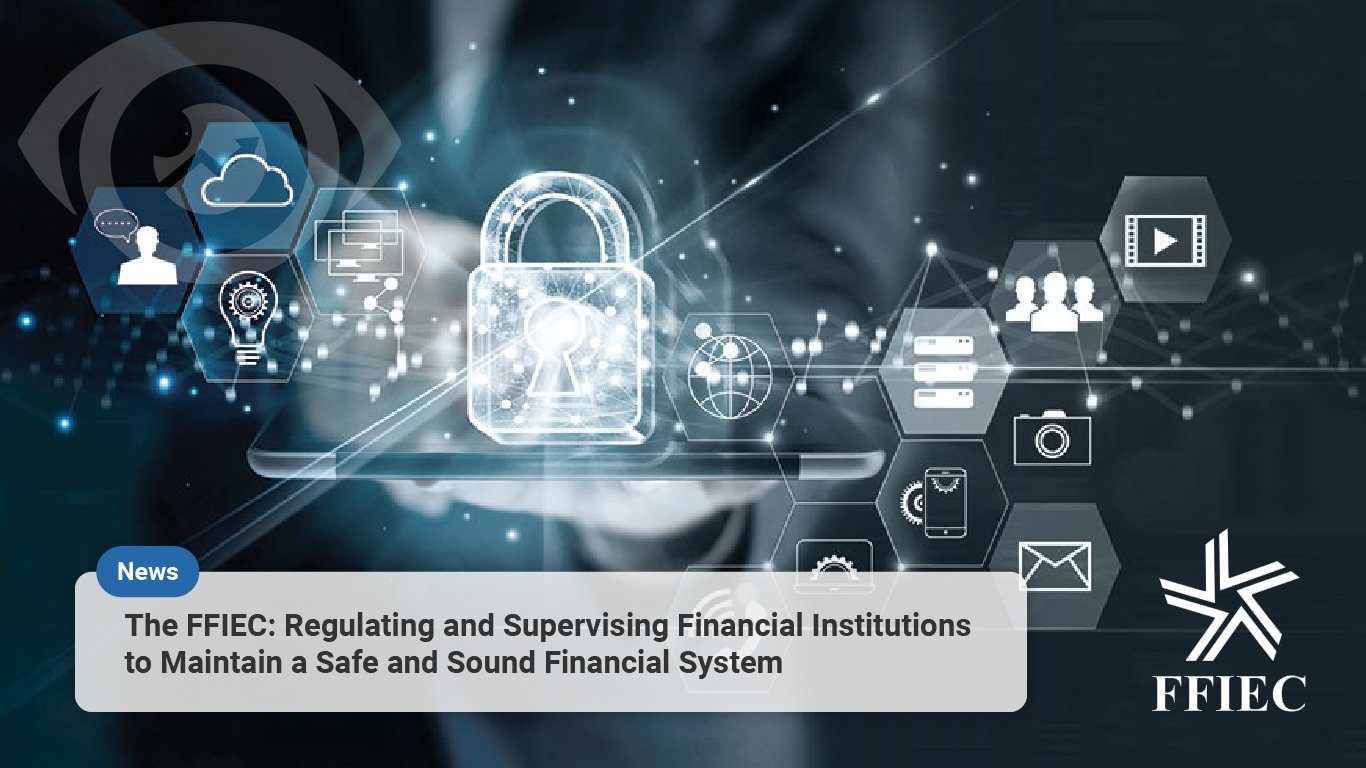Estimated reading time: 9 minutes
Table of contents
- I. Introduction
- II. What is the FFIEC and what does it do?
- III. FFIEC’s examination and supervision standards for financial institutions
- IV. How does the FFIEC coordinate regulatory activities across its member agencies?
- V. What types of institutions does the FFIEC regulate and supervise?
- VI. What is the FFIEC Cybersecurity Assessment Tool (CAT), and how does it help financial institutions assess and manage their cybersecurity risks?
- VII. Conclusion
I. Introduction
The Federal Financial Institutions Examination Council (FFIEC) is a regulatory body that plays a crucial role in supervising financial institutions in the United States. Established in 1979, the FFIEC is composed of several regulatory agencies, including the Federal Reserve System, the Federal Deposit Insurance Corporation, the National Credit Union Administration, and others. Its primary objective is to develop uniform principles, standards, and report forms for the federal examination of financial institutions.
In this article, we will explore the FFIEC’s role in regulating and supervising financial institutions. We will answer several questions, including what the FFIEC is, what it does, how it coordinates regulatory activities across its member agencies, what types of institutions it regulates and supervises, and what the FFIEC Cybersecurity Assessment Tool (CAT) is, and how it helps financial institutions assess and manage their cybersecurity risks. Let’s dive in!
II. What is the FFIEC and what does it do?
The FFIEC is a regulatory body that supervises financial institutions in the United States. It was established in 1979 to promote uniformity in the supervision of financial institutions and to improve the efficiency of the federal examination process. The FFIEC is composed of several regulatory agencies, including the Federal Reserve System, the Federal Deposit Insurance Corporation, the National Credit Union Administration, and others.
The FFIEC’s primary objectives are to identify and address risks to the safety and soundness of financial institutions, protect consumers from predatory and fraudulent practices, and promote fair and equal access to financial services. To achieve these objectives, the FFIEC develops and implements uniform principles, standards, and report forms for the examination of financial institutions. It also provides guidance and training to examiners and supervisory staff to ensure they have the necessary knowledge and skills to carry out their responsibilities effectively.
The FFIEC’s importance in the financial industry cannot be overstated. Its standards and principles are used by examiners and supervisory staff to evaluate the financial condition and risk profile of financial institutions. This information is then used to identify areas where corrective action may be needed to prevent or mitigate potential risks. The FFIEC’s supervision and regulation of financial institutions also help to maintain a safe and sound financial system, which is critical to the overall health of the economy.
III. FFIEC’s examination and supervision standards for financial institutions
The FFIEC’s examination and supervision standards are designed to ensure that financial institutions operate in a safe and sound manner and comply with applicable laws and regulations. The standards cover a range of topics, including capital adequacy, asset quality, management effectiveness, earnings, liquidity, and sensitivity to market risk.
The FFIEC’s examination process is rigorous and thorough. It involves an assessment of a financial institution’s financial condition, risk profile, and compliance with laws and regulations. Examiners use the FFIEC’s uniform principles and standards to evaluate an institution’s operations and identify areas where corrective action may be needed to address deficiencies or mitigate potential risks.
The FFIEC’s supervision of financial institutions is critical in ensuring compliance with regulations and standards. It provides guidance and training to examiners and supervisory staff to ensure they have the necessary knowledge and skills to carry out their responsibilities effectively. It also engages in outreach efforts to promote an understanding of regulatory expectations and encourages institutions to adopt best practices for risk management and compliance.
The impact of the FFIEC’s standards on financial institutions is significant. Compliance with these standards is required for financial institutions to maintain their charters and access to the federal safety net, including deposit insurance and the Federal Reserve’s discount window. Additionally, compliance with the FFIEC’s standards helps financial institutions to manage risk effectively, which is essential to their long-term success and stability.
IV. How does the FFIEC coordinate regulatory activities across its member agencies?
The FFIEC is composed of several regulatory agencies, including the Federal Reserve System, the Federal Deposit Insurance Corporation, the National Credit Union Administration, and others. The FFIEC’s structure is designed to promote coordination and consistency among regulatory agencies by providing a forum for collaboration and information sharing.
The FFIEC’s role in promoting coordination and consistency among regulatory agencies is critical to the effective supervision of financial institutions. The FFIEC provides a platform for member agencies to share information and coordinate their efforts to ensure that regulatory requirements are consistently applied. It also works to promote communication and collaboration among its member agencies and with other federal and state regulatory agencies to address emerging risks and promote a safe and sound financial system.
Examples of how the FFIEC has coordinated regulatory activities in the past include the development of joint guidance on a range of issues, such as the Community Reinvestment Act, fair lending, and consumer compliance. The FFIEC also coordinates with other federal and state regulatory agencies to ensure consistency in the implementation of new regulations, such as the Dodd-Frank Wall Street Reform and Consumer Protection Act. Additionally, the FFIEC collaborates with international regulatory bodies to promote consistency in the supervision of financial institutions across borders.

V. What types of institutions does the FFIEC regulate and supervise?
The FFIEC regulates and supervises a wide range of financial institutions, including banks, savings associations, credit unions, and nonbank financial companies that are designated as systemically important. These institutions play critical roles in the financial system, and the FFIEC’s supervision is essential to maintaining a safe and sound financial system.
The FFIEC’s supervisory process for each type of institution varies depending on the institution’s risk profile, complexity, and other factors. For example, for banks and savings associations, the FFIEC conducts regular on-site examinations to assess the institution’s financial condition, risk profile, and compliance with laws and regulations. For credit unions, the FFIEC conducts both on-site examinations and off-site supervision to ensure compliance with applicable regulations. For designated nonbank financial companies, the FFIEC works with other federal and state regulatory agencies to develop supervisory plans that address the unique risks and challenges posed by these companies.
The importance of the FFIEC’s supervision in maintaining a safe and sound financial system cannot be overstated. Financial institutions play critical roles in the economy, and the health of the financial system is essential to the overall health of the economy. The FFIEC’s supervision helps to identify and address potential risks before they become problems, promoting stability and confidence in the financial system. It also helps to ensure that financial institutions operate in a safe and sound manner, protecting consumers and maintaining the integrity of the financial system.
VI. What is the FFIEC Cybersecurity Assessment Tool (CAT), and how does it help financial institutions assess and manage their cybersecurity risks?
The FFIEC Cybersecurity Assessment Tool (CAT) is a comprehensive resource that helps financial institutions assess and manage their cybersecurity risks. It was developed by the FFIEC to provide a standardized approach for evaluating an institution’s cybersecurity posture and identifying areas where improvement may be needed. The CAT is designed to be used by all financial institutions, regardless of size, and is based on the FFIEC’s cybersecurity framework.
The FFIEC CAT has several components that help financial institutions assess their cybersecurity risks. The first component is the Inherent Risk Profile. This component helps financial institutions assess their inherent risk for cybersecurity threats based on factors such as the type of institution, delivery channels, and external threats. The assessment considers the complexity and interconnectedness of an institution’s systems, the sensitivity of the information that it processes, and the susceptibility to cyber threats.
The second component of the FFIEC CAT is the Cybersecurity Maturity Assessment. This component helps financial institutions assess their cybersecurity preparedness and identify areas where they need to improve. It is divided into five domains: Cyber Risk Management and Oversight, Threat Intelligence and Collaboration, Cybersecurity Controls, External Dependency Management, and Cyber Incident Management and Resilience. Each domain includes several assessment factors that are used to evaluate an institution’s maturity level.
The third component of the FFIEC CAT is the Cybersecurity Maturity Assessment. This component allows financial institutions to measure their cybersecurity maturity against a set of predefined levels and identify areas for improvement. The maturity levels range from baseline to innovative, with the innovative level representing the highest level of cybersecurity maturity.
The FFIEC CAT is an important tool for promoting cybersecurity preparedness in financial institutions. Cybersecurity threats are constantly evolving, and financial institutions need to be proactive in identifying and addressing these threats to protect themselves and their customers. The FFIEC CAT provides a standardized approach for assessing cybersecurity risks and helps financial institutions identify areas where they need to improve their cybersecurity posture. By using the FFIEC CAT, financial institutions can better protect themselves and their customers from cyber threats and demonstrate their commitment to cybersecurity preparedness.
VII. Conclusion
In conclusion, the FFIEC plays a critical role in regulating and supervising financial institutions in the United States. Its objectives are to identify and address risks to the safety and soundness of financial institutions, protect consumers from predatory and fraudulent practices, and promote fair and equal access to financial services.
The FFIEC develops and implements uniform principles, standards, and report forms for the examination of financial institutions, and it provides guidance and training to examiners and supervisory staff. The FFIEC also coordinates regulatory activities across its member agencies, promotes consistency in the implementation of regulations, and engages in outreach efforts to promote an understanding of regulatory expectations.
The FFIEC’s supervision and regulation of financial institutions help to maintain a safe and sound financial system, which is critical to the overall health of the economy. It also helps to protect consumers and maintain the integrity of the financial system.
Furthermore, the FFIEC Cybersecurity Assessment Tool (CAT) is an essential resource that helps financial institutions assess and manage their cybersecurity risks. By using the FFIEC CAT, financial institutions can better protect themselves and their customers from cyber threats and demonstrate their commitment to cybersecurity preparedness.
Overall, the FFIEC’s impact on the financial industry is significant. Its supervision and regulation of financial institutions, as well as its promotion of cybersecurity preparedness, are essential to maintaining a safe and sound financial system. The FFIEC plays a critical role in protecting consumers and promoting fairness and equal access to financial services.
The FFIEC is a regulatory body that supervises financial institutions in the United States. It was established in 1979 to promote uniformity in the supervision of financial institutions and to improve the efficiency of the federal examination process. The FFIEC is composed of several regulatory agencies, including the Federal Reserve System, the Federal Deposit Insurance Corporation, the National Credit Union Administration, and others.
Related Posts




